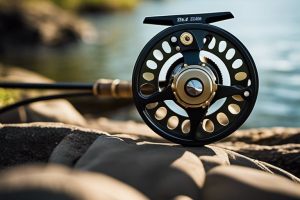Most anglers today take for granted the intricate design of fly reels, blissfully unaware of the journey that brought them here. From the simple hand-crafted wooden models to the sophisticated machined innovations of today, the evolution of fly reels reflects not just technological progress but also the changing needs of anglers like you. In this exploration, you will probe into the rich history of fly reels, uncovering how each innovation paved the way for modern fishing experiences.
The Early Beginnings
Ancient Civilizations and Fishing
The bond between humans and water has fueled countless innovations, with fishing being one of the earliest activities that brought sustenance and community. You may not realize that some of the first records of fishing gear date back to ancient civilizations such as the Mesopotamians and Egyptians. These cultures fashioned early hooks from bone and metal, as well as simple lines made from plant fibers. Fishing was not merely a means of survival; it was woven into the fabric of society, forming a pastime and an art that would evolve over centuries.
The Greeks contributed significantly to this legacy as they refined the tools and techniques used in fishing. You can envision a time when waters were teeming with fish, and fishermen stood at the banks, employing rudimentary reels with the primary purpose of reeling in their catch. These early innovations laid the groundwork for the more specialized fishing tools that would come in later generations, merging functionality with artistry.
Early Fly Fishing Techniques
Fishing has always thrived on creativity, and fly fishing stands out among the myriad techniques for its unique approach. You might find it fascinating that the practice of using artificial flies to lure fish originates from these early days. Techniques began with simple threads and feathers attached to primitive hooks, allowing you to mimic the appearance of insects. Ancient texts, such as those from the Roman author Aelian, describe the use of such flies, illustrating how the concept of fly fishing began to take shape and intertwine with cultural narratives.
Civilizations embraced this notion, crafting makeshift rods that would enable them to cast their lines more effectively. You can see how imagination drove innovation during these formative years. The act of fly fishing became a pursuit of finesse, where anglers sought not just for sustenance but for the thrill of the chase. Early techniques would evolve, yet the essence of fly fishing—blending artistry with skill—remains a constant thread through the tapestry of its history.
The Dawn of Fly Reels
Some of the earliest fly reels began taking form in the 16th century, emerging as a necessity in the pursuit of fish. The fascination with fly fishing found its place among enthusiasts, particularly in England where it became a refined pastime. Reels were simple devices, often crafted from wood or brass, designed to hold line and aid in the casting process. These mechanical reels, while rudimentary, marked the beginning of an evolution that would see substantial improvements in functionality and design over the centuries.
First Mechanical Reels (16th-18th Century)
Century after century, the mechanical reel evolved slightly, yet fundamentally. During the 17th and 18th centuries, reels became more common in angling circles. They were often operated with a simple pop-up mechanism that allowed the line to be drawn in and out with relative ease. The earliest designs were still crude by modern standards, but they represented a leap forward in convenience and control, even if they delivered limited performance. Each reel was a handcrafted piece, often personalized to reflect the skills of the artisan and the preferences of the angler.
Hand-Crafted Reels and Early Innovations
Any angler would recognize that the dawn of fly reels coincided with a period of experimentation and craftsmanship. As the 19th century approached, builders began to hone their skills, leading to innovations in materials and design. The gradual shift from wood to metal enhanced both durability and performance. Some reels started incorporating features such as click-and-pawl mechanisms, which provided audible feedback when line was fed out or retrieved. This evolution culminated in reels that were not only functional but also elegant.
Reels crafted during this period were often tailor-made, reflecting the unique taste and style of their owners. The intricate touches added to each reel became a badge of honor, connecting the angler intimately to their gear. Skilled artisans invested significant time in creating reels that were not only effective but also a joy to use. This era laid the groundwork for the modern innovations that would soon follow, as intrigue around technology and the sport continued to blossom.
Industrial Revolution and Mass Production
Assuming you are curious about the transformation of fly reels, the Industrial Revolution offers a pivotal chapter in their development. This era, spanning the late 18th to the 19th century, introduced revolutionary advancements in manufacturing. As factories sprang up, the production of fishing equipment shifted from small artisan shops to large-scale operations. The transition from handmade to machine-made reels altered not only the reels themselves but also the accessibility for the everyday angler. No longer did you need to seek out a dedicated craftsman; the marketplace now brimming with options opened the door wide for recreational fishing.
Introduction of Machine-Made Reels (19th Century)
Mass production marked a dramatic shift in the design and functionality of fly reels. By the mid-1800s, machine tools enabled manufacturers to create reels with greater precision and uniformity. The introduction of these machine-made reels meant that each piece could be produced more quickly and at a lower cost. This innovation led to the development of lighter materials and intricate designs, catering to various fishing styles while pushing the limits of what was possible for avid anglers.
Standardization and Accessibility
The rise of machine-made reels brought about standardization that would change fishing gear forever. With consistent quality and design, anglers could expect a reliable product with each purchase. This standardization not only made fly reels more affordable but also more widely available. Retailers stocked these reels in large quantities, ensuring that the growing number of hobbyists and professionals alike could find a reel that suited their needs. The burgeoning fly fishing community embraced these advancements, fueling further interest in the sport.
Century after century, the advancements in technology define the landscape of fly fishing. The accessibility of fly reels allowed more people to engage with the sport, fostering a sense of community among anglers. As the Industrial Revolution laid the groundwork for modern manufacturing, it ensured that fly fishing transitioned from a niche activity accessible by few to a beloved pastime enjoyed by many. With the groundwork laid, you watched as the fly reel continued to evolve, each change telling a story of innovation and passion for the pursuit of fish.
The Golden Age of Fly Reels
Your understanding of fly reels takes a significant leap during the late 19th to early 20th century, a period often referred to as the Golden Age of Fly Reels. This era witnessed an explosion of innovation, driven by passionate anglers eager to enhance their fishing experience. You will see that the designs not only became more refined but also incorporated new materials that improved performance, durability, and usability. Anglers moved from the basic wood and brass constructions to aluminum and other lightweight metals, setting the stage for modern fly reel design.
Innovative Designs and Materials (Late 19th-Early 20th century)
With advancements in technology came revolutionary designs. The emergence of the single-action reel allowed for easier line retrieval, while the click-and-pawl mechanism introduced a level of control that many anglers appreciated. Your experience out on the water became more enjoyable as these reels provided a smoother drag system, allowing for better handling of fish. The use of materials like hard rubber and anodized aluminum further enhanced reel performance, offering corrosion resistance and light weight, which were vital for long days of fishing.
Notable Manufacturers and Their Contributions
Contributions from notable manufacturers during this Golden Age cannot be overstated. Brands like Hardy, Pflueger, and Hardy Bros. played crucial roles in shaping the fly reel landscape. Their commitment to innovation and quality set industry standards that many others followed. Hardy’s Perfect reel, for example, became a benchmark for craftsmanship, melding function and form into an object of beauty that you would cherish for generations.
Century after century, the legacies of these manufacturers continue to influence modern fly fishing. They established principles of design, such as spool shape, drag mechanisms, and overall weight, all of which are still relevant today. Your appreciation for fly fishing can be traced back to their dedication to excellence, enabling you to enjoy the rich history and evolution of these crucial tools. Each time you cast your line, you participate in a tradition built upon the innovations of those who came before you.
Post-War Advancements
After the war, fly reel makers embraced a spirit of innovation that transformed the fishing experience. The period marked a significant turning point, as manufacturers sought to modernize their designs, incorporating new techniques and materials. This shift was important, not only for the production of reels but also for the anglers who sought better performance on the water. The results were fly reels that were lighter, easier to use, and capable of handling larger fish than ever before.
New Materials and Technologies (Mid-20th century)
Advancements in materials and technologies during the mid-20th century revolutionized how reels were built. Anglers began to see the introduction of aluminum and plastic into the manufacturing process, both of which reduced weight and increased durability. These materials made it possible for reels to withstand the rigors of freshwater and saltwater fishing alike. A reel you might have picked up in the early 1950s would feel markedly different from those crafted just a decade earlier, as designers experimented with improving drag systems and line capacity.
Increased Focus on Performance and Durability
Focus shifted to delivering a sporting edge that could elevate your fly fishing experience. As fly reels evolved, the emphasis moved towards performance, reliability, and user-friendly features. Innovations such as smoother drag systems became vital for catching elusive fish. Reel manufacturers began to prioritize quality over quantity, knowing that every detail would affect your success on the water.
This newfound emphasis on durability and performance meant that anglers could trust their reels under different conditions. Improved bearings, sophisticated drag mechanisms, and enhanced construction methods allowed you to pursue your passion without worrying about gear failure. The advancements of this era set a foundation for the modern fly reel, forging a connection between you and the experience of fishing that has only grown deeper through innovation.
Modern Era and Contemporary Developments
Despite the rich history of fly reels, the modern era has witnessed an explosion of innovation that has fundamentally changed the way you experience fishing. Technological advancements have paved the way for lighter, stronger, and more efficient reels. You can trace the roots of these developments back to earlier models, but today’s reels often incorporate intricate designs and cutting-edge materials that enhance performance. If you want to investigate into the history of these crucial tools, consider reading Fly Reels of the Past: Orrelle, John, which provides a fascinating backdrop to this evolution. The modern reels you find today often blend traditional craftsmanship with the latest technologies, offering a unique construction that speaks to the angler’s need for reliability and precision.
Advances in Materials Science and Computer-Aided Design
One of the most significant shifts in fly reel development has been the transition to advanced materials and the use of computer-aided design (CAD) technology. With materials like high-grade aluminum and advanced polymers, you will find that modern reels are both lightweight and robust. This transformation allows for reels that withstand the rigors of nature while remaining easy to handle. CAD has also augmented this innovation, enabling manufacturers to create complex geometries that were previously unattainable. It is this marriage of technology and material science that is revolutionizing fly fishing, providing a more responsive experience for you on the water.
Customization and Specialization
Modern fly reels are no longer one-size-fits-all; they have evolved into highly specialized tools tailored to specific fishing styles and preferences. You might find reels designed explicitly for freshwater fishing, saltwater environments, or even specific species of fish. This era has ushered in a wave of customization techniques, allowing anglers like you to adjust drag systems, retrieve ratios, and even aesthetic elements such as color and finishing. It’s an exciting time when you can find a reel that fits not only the technical requirements of your fishing style but also reflects your personal tastes.
Understanding the options available in customization is imperative. Manufacturers now offer adjustable features, which means you can fine-tune your reel according to your skill level and fishing conditions. Whether you prefer a larger arbor for quicker line retrieval or a lightweight design for long days on the water, these specialized reels cater to every angler’s needs. Your fishing experience can be enhanced significantly, providing a sense of connection to your gear that is integral to the sport.
Final Words
To wrap up, your journey through the history of fly reels has revealed a fascinating blend of tradition and innovation. From the rudimentary designs of the early days to the precise craftsmanship found in modern reels, each era has contributed to the evolution you see today. The fly reel, once a mere functional tool, has developed into a piece of art that reflects your passion for the sport. You’ll find that every model tells a story, an intricate narrative of those who dared to fish before you and their relentless pursuit of improvement.
As you continue to explore the nuances of fly fishing, remember the lessons imparted by history. Seek out reels that resonate with your journey, like the Old Florida No. 4 through 7, 44 though 88: History and …, and appreciate their place in the broader tapestry of the fishing experience. Ultimately, the evolution of fly reels is more than a chronicle of technological achievement; it is a testament to your enduring connection to nature and the quest for mastery in every cast.
FAQ
Q: What are the significant milestones in the development of fly reels throughout history?
A: The evolution of fly reels can be traced back to the 19th century when the first rudimentary reels were developed. Significant milestones include the introduction of the first click-and-pawl reel in the late 1800s, which improved drag and line management. The 1930s saw the development of the first mass-produced aluminum reels, making them lighter and more durable. The 1970s brought the introduction of closed-face reels and advanced drag systems, allowing for smoother performance. More recently, materials like carbon fiber and advancements in precision engineering have led to the production of high-performance reels appreciated by modern anglers.
Q: How have technological advancements influenced fly reel design and performance?
A: Technological advancements have significantly impacted fly reel design and performance, leading to improved materials and mechanics. Innovations such as the use of lightweight composites and strong alloys have reduced reel weight while maintaining durability. The introduction of precise drag systems, including disc and sealed drag mechanisms, has enhanced performance, allowing anglers to handle larger fish with greater control. Additionally, computer-aided design (CAD) allows for more intricate designs that optimize weight distribution and improve aesthetics, making modern fly reels both functional and visually appealing.
Q: How does the evolution of fly reels reflect changes in fishing techniques and angler preferences?
A: The evolution of fly reels mirrors changes in fishing techniques and angler preferences over the years. As fly fishing has evolved from a primarily leisure activity to a more specialized sport, the demand for performance and reliability has increased. Reels have evolved to cater to different fishing styles, such as saltwater versus freshwater fly fishing, with specific designs tailored to each environment. Additionally, the rise of catch-and-release practices has influenced the need for smoother drags and lighter tackle, reflecting an increased awareness of sustainable fishing practices. Overall, the development of fly reels illustrates a responsive relationship between technology, technique, and angler needs.


